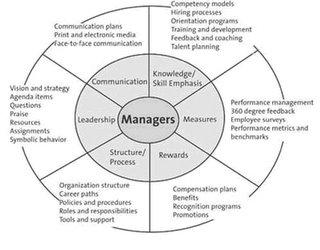Three ways to improve manager communication
Three ways to improve manager communication
How to harness the organization’s most popular information source.
by Andy Szpekman, president, AHS Communications
Managers are popular sources of information because employees often have little interest in what’s communicated through other sources. Much of what they read on the intranet, see on closed circuit television or hear from senior executives might be mildly enlightening, but it has little impact on their day-to-day lives.
Managers, on the other hand, can relay information that applies directly to people’s jobs and careers. They can provide performance feedback and recognition, discuss opportunities for professional development and career advancement and hold salary reviews. Other sources of information, no matter how well crafted or well intentioned, are hard-pressed to provide such compelling news.
If improving the management skills of your organization’s managers is a business priority, here’s a simple three-step process you can use to help make them better communicators. One tip before we get started: don’t expect to go it alone. You’ll need support from HR and senior management to be successful.
Step one: Define manager communication accountabilities
When employees think of “good manager communication,” they are generally envisioning a manager who engages in frequent, two-way dialogue about topics the employee finds personally meaningful. They are picturing a manager who, besides giving performance feedback, involves employees in important decisions, recognizes contributions, discusses career and professional development, and is receptive to ideas and suggestions. Employees are not thinking of a manager who provides frequent briefings on companywide programs, updates on other departments’ activities and messages from the chairman.
Here are a list of actions all managers at Bank of America (where I was previously head of HR communications) are expected to take:
· Communicating clear and specific performance expectations and measures of success.
· Providing candid performance feedback.
· Conducting formal reviews at least once a year to appraise performance, plan career and professional development, and discuss compensation.
· Encouraging associates to speak openly and candidly about issues.
· Explaining business unit goals and results, and how associate contributions made a difference.
· Encouraging and rewarding associates who do the right thing for customers, clients and shareholders.
Has your company defined a similar list? If not, I urge you to do so as a first step in improving manager communication.
Step two: Motivate managers to communicate
If you want managers to communicate with employees, you need to consider the items in the figure below. For example:
· Do senior leaders serve as communication role models?
· Do manager hiring, coaching and development processes emphasize communication skills?
· Do incentive and recognition programs reward manager communication?
Motivating managers to communicate
 Step three: Provide training and tools
Step three: Provide training and toolsOnce managers know what they are expected to communicate and are motivated to do it, they will view communication training and tools as resources that can help them meet their business objectives.
From my experience, managers need competencies in four areas, shown in the figure below. Based on how you define managers’ communication accountabilities, your list of competencies might be different, but this provides a good starting place.
Developing managers' communication competencies

For the actual training session, here’s the agenda I would follow. Start off by explaining the benefits of improved employee communication from the manager’s perspective – i.e., more motivated and productive employees. Next, describe the type of communication employees want from their managers. We covered this in the first part of the article. Use the balance of the session to review the competencies managers need, and then let managers practice demonstrating these competencies.
Here are a few best practices to follow:
· Keep the sessions brief. Two hours is usually long enough.
· Begin or end the session with a senior leader emphasizing the importance of manager communication.
· Use role-play to give managers the chance to practice what they learned and critique each other in small groups. Rotate managers through the roles of manager, employee and observer.
· Provide reference materials and resources managers can use after the training to continue building their skills.
· Be realistic. Don’t expect to transform anyone after a one-time event. Set practical goals and craft a plan to build on your progress.
Part of your ongoing campaign to help managers communicate more effectively might involve developing a standardized communication tool. At Bank of America we developed a "huddle template" (see below). Sometimes, it’s filled out and given to managers. Other times, managers complete the blank template themselves to prepare for a team meeting about an important change. The huddle is meant to be brief, as it generally occurs before or after a shift. The meeting structure, however, is adaptable, and an actual huddle can be shorter or longer depending on the topic.
The communication huddle template

Management’s big advantage
When you add up employees’ communication needs and managers’ accountabilities, it may seem like a tall order to get managers to communicate effectively. But managers possess a big advantage: they know their teams well. They know their team’s interests and subject-matter knowledge. They know how their team will respond to an issue. They understand the work environment, and they are generally seen as trustworthy. In short, managers have the insight necessary to tailor information to their audience’s needs – something few communicators are as qualified to do.
Source: The Hub, Melcrum Publishing


0 Comments:
Een reactie posten
<< Home